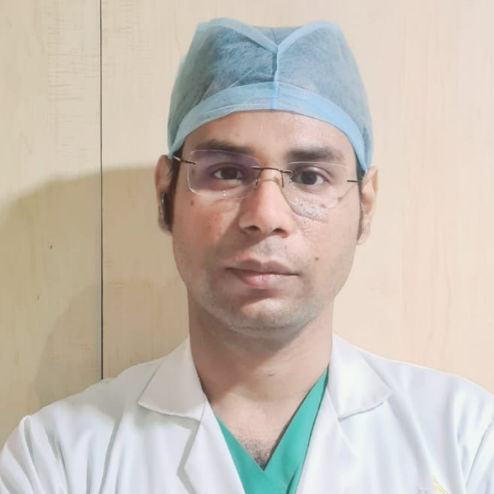Mechanical Thrombectomy: A Lifesaving Procedure for Stroke
Learn how mechanical thrombectomy works, who it can help, its benefits, risks, recovery, and why acting fast during a stroke saves lives.

Written by Dr. M L Ezhilarasan
Reviewed by Dr. Dhankecha Mayank Dineshbhai MBBS
Last updated on 29th Sep, 2025

Introduction
Imagine a traffic jam in a major artery leading to a city’s centre. Now, imagine that city is your brain. A stroke occurs when a blood clot creates a similar blockage, cutting off vital oxygen and nutrients to brain cells, which begin to die within minutes. Mechanical thrombectomy is a revolutionary medical procedure that acts like a high-precision tow truck, physically removing the clot and restoring blood flow to save brain tissue and function. This minimally invasive technique has dramatically changed the landscape of stroke treatment, offering hope where there was little. In this guide, we will break down everything you need to know about mechanical thrombectomy—from how it works and who it can help, to what the recovery process entails. Understanding this procedure can empower you to recognise stroke symptoms and act fast, a critical factor in saving lives and preserving quality of life.
What is a Mechanical Thrombectomy? The Basics Explained
A mechanical thrombectomy is a minimally invasive, image-guided surgical procedure designed to remove a blood clot from a blocked artery in the brain. It’s a type of endovascular therapy, meaning the surgeon accesses the problem from within the blood vessels, avoiding the need for open brain surgery.
Think of it as a highly skilled plumbing job for your arteries. A specialist, typically an interventional neurologist or radiologist, threads a thin, flexible tube called a catheter through an artery in the groin or wrist. Using real-time X-ray imaging (fluoroscopy), they navigate this catheter all the way up to the precise location of the clot in the brain. Once there, they use specialised devices passed through the catheter to either grab the clot with a stent retriever (a tiny, mesh-like device that traps the clot) or suction it out with an aspiration catheter. The clot is then removed, and blood flow is restored.
Thrombectomy vs. Thrombolysis: What's the Difference?
It's common to confuse these two terms, but they represent fundamentally different approaches to treating an ischaemic stroke (stroke caused by a clot).
- Thrombolysis: This is a "clot-busting" approach. It involves administering a powerful medication called tPA (tissue plasminogen activator) through an IV line. The drug circulates in the bloodstream and works to dissolve the clot chemically. The major limitation is the strict time window—it's typically only given within 4.5 hours of symptom onset.
- Mechanical Thrombectomy: This is a "clot-removal" approach. It physically extracts the clot. The key advantage is its extended time window. For eligible patients, mechanical thrombectomy can be performed up to 6, and in some select cases, even 24 hours after symptom onset. It is also the only effective treatment for large, stubborn clots that won't dissolve with medication alone.
Consult a Neurologist for the best advice
The Critical Role in Stroke Treatment: Why "Time is Brain"
The mantra in stroke care is "Time is Brain." For every minute a stroke goes untreated, a person loses about 1.9 million neurones. This highlights the incredible urgency of treatment. Mechanical thrombectomy has proven to be a game-changer because it can salvage brain tissue even after the window for thrombolysis has closed, significantly improving patient outcomes.
Studies have shown that for patients with a large vessel occlusion (LVO)—a blockage in one of the brain's major arteries—undergoing a successful thrombectomy procedure can dramatically increase the likelihood of regaining functional independence. Where previous treatments might have left patients with severe disabilities, thrombectomy can lead to remarkable recoveries.
Understanding Ischaemic Stroke and Large Vessel Occlusion (LVO)
An ischaemic stroke accounts for about 87% of all strokes. It occurs when an artery supplying blood to the brain is obstructed. A Large Vessel Occlusion is a particularly severe type of ischaemic stroke where the blockage is in a primary artery, such as the internal carotid artery or the middle cerebral artery. These blockages cause widespread damage quickly. Mechanical thrombectomy is specifically designed to treat these life-threatening LVO strokes.
Who is a Candidate for Mechanical Thrombectomy?
Not every stroke patient is a candidate for this procedure. The decision is made by a specialised stroke team based on several critical factors, determined through rapid brain imaging (like a CT Angiogram):
- Type of Stroke: It is only for ischaemic strokes caused by a clot. It is contraindicated for haemorrhagic strokes (bleeding in the brain), as removing a clot in this case could worsen the bleed.
- Location of the Clot: The clot must be in a large, accessible artery (a Large Vessel Occlusion).
- Size of the Damaged Area: Advanced imaging (CT Perfusion or MRI) can identify brain tissue that is at risk but not yet dead (the "ischaemic penumbra"). If a significant amount of salvageable tissue remains, the patient is a strong candidate.
- Time Since Symptom Onset: The standard window is within 6 hours, but this can be extended up to 24 hours for some patients who meet specific imaging criteria.
- Overall Health: The patient must be stable enough to undergo the procedure.
If you or a loved one experiences sudden stroke symptoms, it is a medical emergency. Call an ambulance immediately. Do not wait to see if symptoms improve. Consulting a doctor online with Apollo24|7 can be a good first step for non-emergency concerns, but for suspected stroke, always go to the nearest emergency room equipped with a stroke centre.
The Step-by-Step Thrombectomy Procedure
Step 1: Diagnosis and Rapid Imaging
The process begins in the Emergency Room. The team acts quickly to confirm a stroke using a FAST assessment (Face drooping, Arm weakness, Speech difficulty, Time to call). A non-contrast CT scan rules out bleeding. Then, a CT Angiogram is performed to locate the exact clot.
Step 2: The "Keyhole" Access and Navigation
The patient is taken to an angiography suite. Under anaesthesia or sedation, the interventionalist makes a tiny puncture in the femoral artery in the groin (or sometimes the radial artery in the wrist). A catheter is inserted and guided through the aortic arch and into the arteries of the neck and brain, using live X-ray as a map.
Step 3: Clot Retrieval or Aspiration
Once the catheter tip is near the clot, the surgeon chooses a retrieval method:
- Stent Retriever: A wire-mesh stent is passed through the catheter and expanded within the clot, embedding itself. It is held in place for a minute or two, then the stent and the trapped clot aregently withdrawn back into the catheter and out of the body.
- Aspiration: A large-bore catheter is positioned at the face of the clot, and powerful suction is applied to pull the clot into the catheter.
The process may be repeated several times to ensure complete removal.
Step 4: Closing the Access Site
After the clot is removed and blood flow is confirmed, the catheter is withdrawn. The small puncture site in the groin or wrist is closed with pressure, a closure device, or a stitch.
Benefits and Potential Risks of the Procedure
Benefits:
- High Success Rate: Restores blood flow in over 80-90% of cases.
- Improved Outcomes: Significantly increases the chance of a good functional recovery.
- Minimally Invasive: No large incisions; faster recovery than open surgery.
- Extended Treatment Window: Offers hope beyond the time limit for clot-busting drugs.
Risks:
As with any procedure, there are risks, though serious complications are relatively rare. These can include:
- Bleeding or damage at the catheter insertion site.
- Damage to the blood vessel wall (dissection).
- The clot breaking off and travelling to a new location (distal embolism).
- Bleeding in the brain (intracranial haemorrhage).
The stroke team carefully weighs these risks against the much greater risk of leaving a major stroke untreated.
The Road to Recovery: What to Expect After a Thrombectomy
The Immediate Post-Procedure Period
After the thrombectomy procedure, the patient is monitored closely in an Intensive Care Unit (ICU) or a dedicated stroke unit. The medical team watches vital signs and neurological status. Further medications, like blood thinners, may be administered to prevent new clots from forming.
Long-Term Rehabilitation and Lifestyle Changes
The recovery journey is unique to each individual and depends on the extent of brain damage that occurred before blood flow was restored. Rehabilitation is crucial and often involves:
- Physical Therapy: To regain strength, balance, and coordination.
- Occupational Therapy: To relearn daily activities like dressing and eating.
- Speech Therapy: To address problems with speaking or swallowing.
Long-term, managing risk factors like high blood pressure, diabetes, and high cholesterol is essential to prevent future strokes. Apollo24|7 offers convenient home collection for tests like HbA1c and lipid profiles to help you monitor these conditions easily.
Conclusion
Mechanical thrombectomy represents one of the most significant advances in modern medicine, turning devastating strokes into treatable events. By directly addressing the blockage causing the brain attack, this procedure offers a tangible chance at recovery that was unimaginable just a couple of decades ago. Its success, however, hinges entirely on the speed of action from the moment symptoms first appear. Knowing the signs of a stroke—face drooping, arm weakness, slurred speech—and calling for emergency help without delay can make the difference between a life of disability and a return to independence. If you have risk factors for stroke, such as atrial fibrillation or high blood pressure, speak with your doctor about prevention strategies. Remember, when it comes to stroke, time lost is brain lost. Empower yourself with this knowledge, and share it with your loved ones—it could save a life.
Consult a Neurologist for the best advice
Consult a Neurologist for the best advice

Dr. Avinash Gupta
Neurologist
12 Years • MBBS, DNB - Neurology
Bilaspur
Apollo Hospitals Seepat Road, Bilaspur
(150+ Patients)

Dr. Joydeep Biswas
Neurologist
15 Years • MBBS, DNB General Medicine, DNB Neurology
Barasat
Diab-Eat-Ease, Barasat

Dr. Uddalak Chakraborty
Neurologist
8 Years • MBBS, MD(GENL.MED.),DM(NEUROLOGY)
Kolkata
MCR SUPER SPECIALITY POLY CLINIC & PATHOLOGY, Kolkata
(25+ Patients)

Dr Debnath Dwaipayan
Neurosurgeon
9 Years • MBBS, MS(Gen. Surgery), DrNB (Neurosurgery)
Delhi
Apollo Hospitals Indraprastha, Delhi

Dr. Uddalak Chakraborty
Neurologist
8 Years • MBBS,MD(GENL. MED.),DM(NEUROLOGY)
Kolkata
VDC Clinic, Kolkata
Consult a Neurologist for the best advice

Dr. Avinash Gupta
Neurologist
12 Years • MBBS, DNB - Neurology
Bilaspur
Apollo Hospitals Seepat Road, Bilaspur
(150+ Patients)

Dr. Joydeep Biswas
Neurologist
15 Years • MBBS, DNB General Medicine, DNB Neurology
Barasat
Diab-Eat-Ease, Barasat

Dr. Uddalak Chakraborty
Neurologist
8 Years • MBBS, MD(GENL.MED.),DM(NEUROLOGY)
Kolkata
MCR SUPER SPECIALITY POLY CLINIC & PATHOLOGY, Kolkata
(25+ Patients)

Dr Debnath Dwaipayan
Neurosurgeon
9 Years • MBBS, MS(Gen. Surgery), DrNB (Neurosurgery)
Delhi
Apollo Hospitals Indraprastha, Delhi

Dr. Uddalak Chakraborty
Neurologist
8 Years • MBBS,MD(GENL. MED.),DM(NEUROLOGY)
Kolkata
VDC Clinic, Kolkata
More articles from Stroke
Frequently Asked Questions
What is the success rate of a mechanical thrombectomy?
Success is measured in two ways: technical success (restoring blood flow) occurs in over 80-90% of procedures. Clinical success (a patient achieving functional independence) is significantly higher with thrombectomy compared to standard medication alone, with studies showing numbers can be double or more for eligible patients.
How long does the procedure take?
The actual clot retrieval process typically takes between 30 to 90 minutes. However, the entire process, from preparation in the angiography suite to closing the incision, can take several hours.
What is the recovery time after a thrombectomy?
There is no single timeline. Immediate hospital stay is usually 5-7 days. The most rapid recovery often happens in the first 3-6 months, but neurological improvement can continue for a year or more with dedicated rehabilitation.
Can a thrombectomy be performed twice?
Yes, if a person has another large vessel occlusion stroke in the future and meets the criteria, a thrombectomy procedure can be repeated. The decision is made by the stroke team based on the individual's specific circumstances.
What are the signs of a large vessel occlusion stroke that might require a thrombectomy?
Symptoms are often severe and sudden. Key signs include complete weakness or paralysis on one side of the body, severe facial droop, inability to speak or understand speech, and a sudden loss of vision. These require immediate emergency care.




